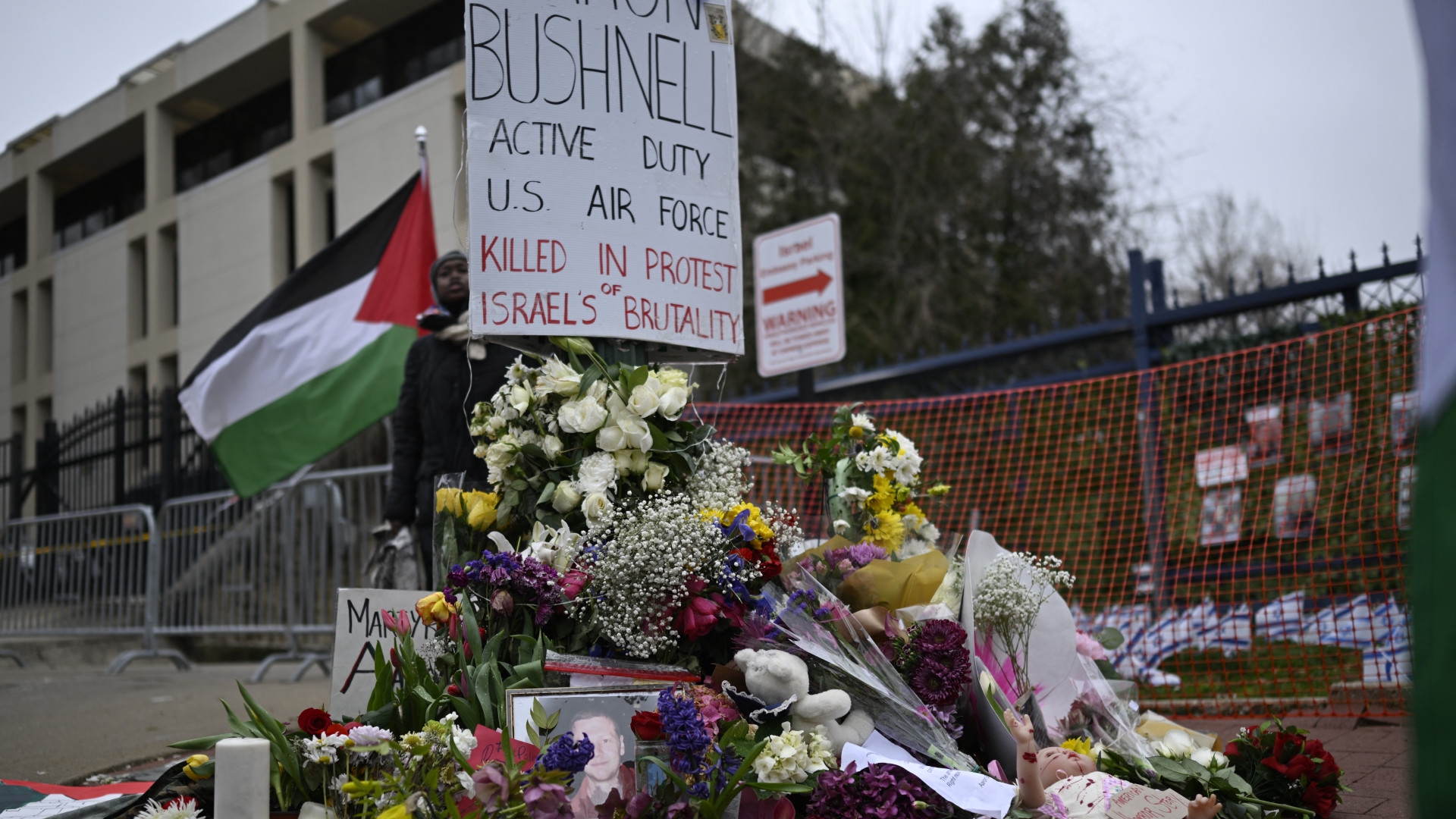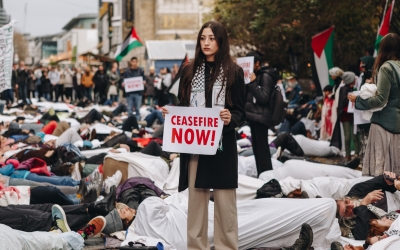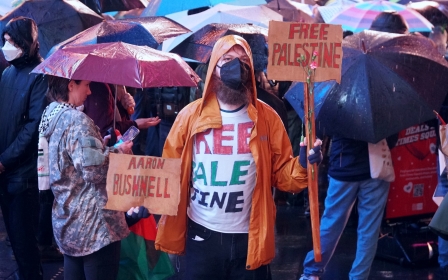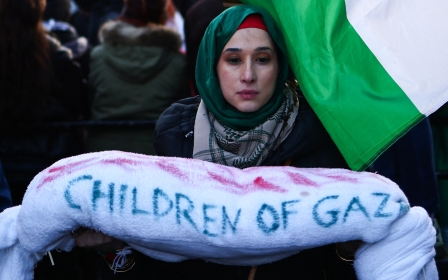War on Gaza: Why Aaron Bushnell's death was a call to action

By the time Aaron Bushnell, a 25-year-old active-duty member of the US Air Force, set himself alight in front of the Israeli embassy in Washington, DC, last weekend, Israel had killed at least 38,000 Palestinians in its ongoing genocide in Gaza.
The indiscriminate and widespread violence and destruction that Israel has subjected Palestinians to since 7 October 2023, with full US backing, is precisely what drove Bushnell to commit this final and direct act of protest.
On 25 February, Bushnell began live streaming on the video platform Twitch, declaring that he could "no longer be complicit in genocide". He said: "I am about to engage in an extreme act of protest, but compared to what people have been experiencing in Palestine at the hands of their colonisers, it's not extreme at all. This is what our ruling class has decided will be normal."
Bushnell died the next day as a result of his injuries. In the final moments of his life, he could be heard yelling, "Free Palestine".
Bushnell's protest follows another act of self-immolation by an American protesting Israel's genocidal assault on Gaza. In December, a person holding a Palestinian flag set themselves on fire outside of the Israeli consulate in Atlanta in what police described as "likely an extreme act of political protest". The individual survived but was reportedly in critical condition.
New MEE newsletter: Jerusalem Dispatch
Sign up to get the latest insights and analysis on Israel-Palestine, alongside Turkey Unpacked and other MEE newsletters
Despite the shared motivations for their protests, the news of Bushnell's self-immolation was met with greater disbelief and shock that a US military service member would be so fundamentally disturbed by US state-backed violence that he would take his own life.
As soon as the story broke, US mainstream media outlets waged what seemed to be a coordinated campaign of obfuscation and character assassination as both an attempt to shield Israel from criticism and diminish the deep political commitment behind Bushnell's act of protest.
Obscuring the facts
In what has become standard New York Times editorial practice, the reasons for why things happen are conspicuously omitted. People mysteriously "die" in Gaza; sometimes, they are even "killed" - but readers are not told who killed them. Similarly, a man may "set himself on fire", but his reasons - even if he states them in no uncertain terms - are not given.
Several outlets highlighted Bushnell's 'anarchist' past while ignoring the issues that inspired his political protest, namely US support for Israel's genocide
Many astute readers caught the initial headline of The New York Times report on Bushnell, such as X user @JoshuaPHill, who noted that the piece "does not mention any direct connection between his action and Israel's genocide in Gaza".
After receiving backlash, the headline appears to have been scrubbed from The Times's website, but it is hardly an outlier. Several other mainstream outlets, including CNN, Reuters, and the Washington Post, published nearly identical headlines in their coverage of Bushnell's political protest. The media's failure to identify the reasons for his act triggered a "barrage of criticism" on social media, which has served as an alternative source for real-time reporting and images of the horrors of Israel's present crimes in Gaza.
Once again, the mainstream media has deliberately obscured the impact of the genocide and elided the role of the US government, in particular, in providing diplomatic cover and military and financial support to Israel. Instead, western reporters have constructed a narrative built on Bushnell's alleged mental health issues, conservative religious upbringing, and other rationales for his actions.
Often keen on maligning acts of resistance and resistance movements, news outlets such as The Independent, The Guardian, and New York Magazine all published articles highlighting Bushnell's childhood and his upbringing in a strict religious community. According to New York Magazine, "Bushnell grew up in a religious group on Cape Cod called the Community of Jesus, whose former members have come forward alleging abuse and a rigid social structure."
Follow Middle East Eye's live coverage of the Israel-Palestine war
A former member of his religious congregation reportedly told The Washington Post that it was common for members of the community to join the military, describing this transition as going from "one high-control group to another high-control group".
To further muddy the reasons for Bushnell's protest and divert attention from Israel's relentless attacks on more than two million Palestinians, several outlets highlighted Bushnell's "anarchist" past and leanings while ignoring the issues that inspired his political protest, namely US support for Israel's genocide.
The US media has largely papered over the political dimensions of Bushnell's protest in favour of promoting a mental health angle. A brief MSNBC segment covering Bushnell's protest, with an Israeli flag in the background, states that he was protesting the "Israel-Hamas war" and ended with information on how to contact the suicide and crisis lifeline. A Huffington Post piece similarly ends with information about a suicide hotline.
It is common practice to include suicide prevention information when stories involve individuals who have chosen to end their lives. However, the inclusion of this information without the appropriate context represents nothing less than a deliberate attempt to pathologise Bushnell while also expressly ignoring the ways in which suicide by self-immolation is a distinct and intentional political act rooted in challenging collective injustice, particularly in cases of asymmetrical warfare.
More sinister yet is the claim in a recent Jerusalem Post piece that solidarity statements with Bushnell's individual protest "puts the US closer to suicide bombings". It disingenuously frames comments by presidential candidates Cornell West and Jill Stein as "support for suicide" while arguing that Bushnell's voluntary sacrifice "is another step toward more political violence".
Criticism of Bushnell's "political violence" was also a point made in a Guardian article last week. In both cases, the authors' choice to highlight self-immolation as a form of political violence distracts from the catastrophic levels of state violence that Bushnell's act of protest was calling attention to.
In his article, "When costs are benefits: Communicative suffering as political protest", sociologist Michael Biggs, who has studied self-immolations extensively, aptly summarises the process by which a protester's motivations - and the act itself - may be discredited. He states: "Even when someone indisputably dies for a cause, as with self-immolation, this can be discounted by the refusal to grant agency: the protester was mentally deranged, or was duped by a movement organisation."
Thus, not only does the media deny Bushnell the presumption that his act could have been a rational and calculated decision of protest, but it further obscures and cements ignorance in the American body politic to avoid contending with serious matters of injustice - in this case, the genocide of Palestinians by Israel.
An urgent call
Bushnell's act follows a long history of self-immolation as a protest tactic that bears revisiting. Many are familiar with the famous image of the "burning monk", or Thich Quang Duc, a Vietnamese Buddhist monk who was photographed as flames engulfed his entire body in 1963. He was challenging the persecution of Buddhists following the imposition of Catholicism by the Diem regime in South Vietnam. Quang Duc, whose act inspired many others, wanted his self-immolation to serve "as a donation to the struggle".
Other self-immolations followed, including in India in 1964 by a Tamil labourer over the imposition of the Hindi language, and in South Korea in 1965 by an individual protesting his country's post-war treaty with Japan.
In 1965, two Americans - Alice Herz and Norman Morrison - also self-immolated in protest of the Vietnam War. By the end of 1965, according to Biggs, "self-immolation had entered the global repertoire of protest".
Perhaps the most famous self-immolation of the 21st century was that of Mohamed Bouazizi, the struggling Tunisian fruit vendor whose self-immolation in 2011 sparked the Arab Spring across the region. Bouazizi's act of protest was a call to action for Arabs who had become complacent toward the tyranny of their governments for far too long.
In the case of Bushnell, the media's conflation of his political grievances with suicide based on personal struggles stems from both ignorance and malicious intent. In his work on self-immolation, Biggs refers to self-immolation as a form of "communicative suffering". Self-inflicted suffering - done without harming others - "reveals the various ways in which suffering can become a source of power."
In this vein, suffering is meant to mobilise and stir up collective action, not just immediately but also in the reverberating and haunting message that justice must continue posthumously. Death, in this context, occurring through the killing of one's own body, becomes a vehicle through which political life can be mobilised.
Through the lens of thanatopolitics - the politics of death - self-immolation is a call and response whereby those receiving the message conveyed by the protestor are, in turn, called to "engage in a common struggle against oppression, humiliation, and injustice".
As shallow understandings of self-immolation abound, several western commentators have gone a step further by criticising Bushnell's political protest. A piece in the Guardian argues that "acts of self-immolation are rare, but they have a clear intent: to use a grotesque display of self-sacrifice to draw the public's attention to an issue, to force them into moral witness".
It is about carrying out an act so extreme that the only logical response from anyone with a moral compass is to carry forward the torch of justice that the protester lit
But that is not where the goal of self-immolation ends: the protester does not merely want the public to "witness" but to take collective action. It is about carrying out an act so extreme that the only logical response from anyone with a moral compass is to carry forward the torch of justice that the protester lit.
While the author of The Guardian article also imposes her judgement that Bushnell could "be much more useful to the world if he were alive", it is critical to recognise the agency of the individual who chooses self-immolation as a protest tactic. Specifically, this individual has decided that there is no other way to disrupt the status quo. In other words, they have already questioned the utility of their life versus death to effect social change.
In his final post on Facebook, Bushnell wrote: "Many of us like to ask ourselves, 'What would I do if I was alive during slavery? Or the Jim Crow South? Or apartheid? What would I do if my country was committing genocide?' The answer is, you're doing it. Right now."
If there had been any doubt about the role of the US as not just a supporter but an active partner in Israel's genocide of Palestinians, Bushnell claimed to have discovered evidence of US troops fighting in Gaza. For someone already so distressed by his complicity, this revelation was perhaps the death blow that drove him to self-immolate.
Thich Nhat Hanh, a Vietnamese monk and peace activist, wrote to Martin Luther King Jr in 1965: "To burn oneself by fire is to prove that what one is saying is of the utmost importance. There is nothing more painful than burning oneself. To say something while experiencing this kind of pain is to say it with the utmost of courage, frankness, determination and sincerity."
Biggs notes that although self-immolation is rare, "it provides a significant theoretical lesson: suffering can serve to advance a collective cause". But any act of self-immolation begs us to go beyond theory and meet the call for justice.
While Palestinians continue to face genocide, Bushnell's call could not be clearer or more urgent.
The views expressed in this article belong to the author and do not necessarily reflect the editorial policy of Middle East Eye.
Middle East Eye delivers independent and unrivalled coverage and analysis of the Middle East, North Africa and beyond. To learn more about republishing this content and the associated fees, please fill out this form. More about MEE can be found here.






